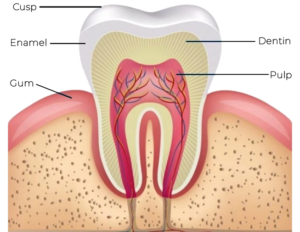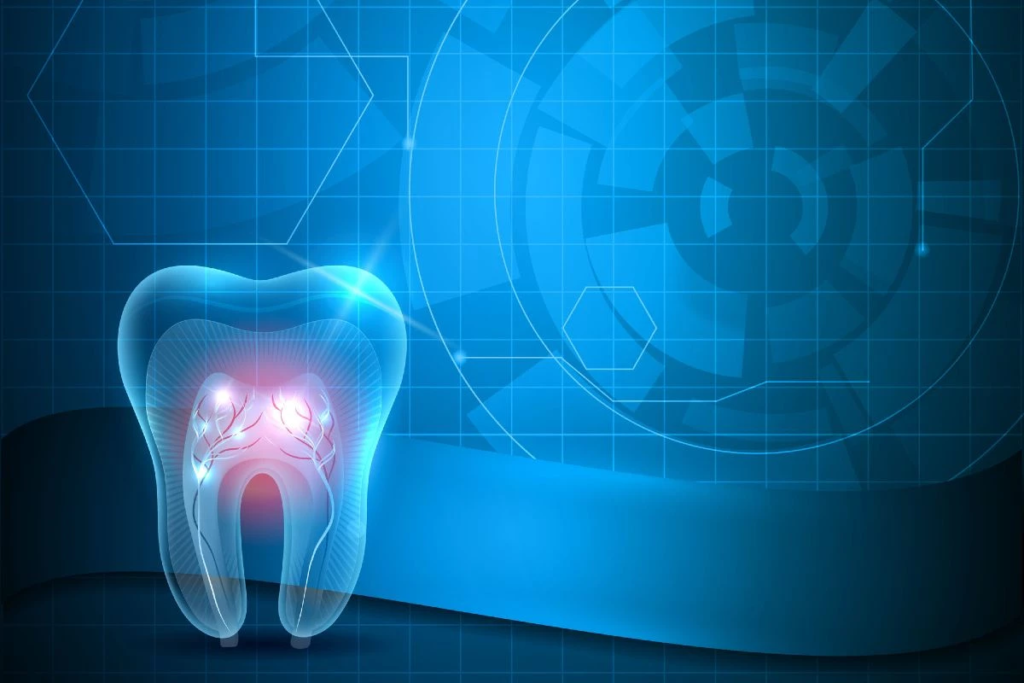We offer Teeth Whitening at each of our locations:

Many people are interested in whitening their teeth or getting into the teeth whitening business. Whereas not everyone needs to understand how the tooth appears more white at the molecular level, anyone wanting to offer teeth whitening services should be able to explain the science behind teeth whitening to their customers. If you are looking to whiten your teeth, it will help you to understand teeth whitening science so you can choose the solution that best helps you meet your goals.
Enamel
Tooth enamel is the hard, protective, outer layer. It is transparent and does not retain any stains in it. You can easily remove stains that accumulate on the surface of tooth enamel through mechanical action such as brushing and polishing.
Even though enamel seems like a solid surface, it contains numerous microtubules from the surface to the dentin. Stains find their way through these tiny tubes and deposit within the dentin layer.
Dentin
Dentin is much softer and more porous than tooth enamel. It serves as a buffer between the surface of the tooth and sensitive nerves.
Dentin gives teeth their color, which is determined by a combination of natural pigment and stains. Genetics determine natural pigment. Some people have white dentin, while others have slightly yellow dentin. Some dentists claim to be able to change the natural pigment with bleaching. Theoretically, maybe it’s possible. However, we don’t make such claims and focus on bleaching stains in the dentin, not the natural dentin color.
Pulp
The pulp is the innermost part of the tooth’s anatomy and contains the connective tissue, nerves, and blood vessels that keep the tooth “alive” and can make it sensitive to hot, cold, cavities, and even teeth whitening. We call the small bursts of pain that people with sensitive teeth feel when they whiten their teeth, “zingers.” If you get zingers, at least you know the gel has made its way to the dentin level and is doing its job. However, you may need to use a milder whitening gel and/or a desensitizing gel or toothpaste.
OXYGEN RADICALS & STAINS
Because the enamel layer is porous, staining particles from coffee, tobacco, wine, tea, etc., seep through the pores and accumulate in the dentin. The more particles that get through, the more discolored (stained) your teeth become.
The best way to bleach or whiten something is with oxygen radicals. Oxygen radicals are electrically charged and ready to bond with, or oxidize, substances like stains. The most effective teeth-whitening substance available today is hydrogen peroxide (HP) because it breaks down into water molecules and free oxygen radicals. Here is the molecular formula:
H2O2 = H2O + O
H2O2 (hydrogen peroxide) = H2O (water) + O (free oxygen radical)
HOW TOOTH BLEACHING WORKS
As soon as you apply hydrogen peroxide (or carbamide peroxide) tooth whitening gel to the surface of the teeth, it starts to break down. The oxygen radicals travel through the pores in the enamel until they reach the dentin layer and oxidize any stains they contact with.
The higher the concentration of peroxide in the gel, the more free radicals and bleaching power. However, the higher the peroxide content, the greater the tooth sensitivity and the potential for gum irritation. The best teeth whitening gel formulations achieve the delicate balance between effectiveness and tooth sensitivity.
Beaming White makes teeth-whitening gels in various strengths that achieve this balance. Our flagship product is our Advanced Whitening Kit, for professional use only, with our famous 16% hydrogen peroxide gel. With this gel, you can achieve dramatic whitening results for the majority of your clients, with little to no tooth sensitivity, in just one hour

Teeth whitening, also known as bleaching, is the act of removing stains from the teeth, which in turn makes them look whiter. There are surface stains that reside on the tooth’s enamel. You can usually remove surface stains by simple mechanical means such as tooth brushing or polishing. Usually, the dentist polishes teeth. But even polishing only removes surface stains, and surface stains come back quite readily.
What we mean by teeth whitening is the bleaching or whitening of the stains on the dentin layer of the tooth. If you look at an anatomical drawing of a tooth, you’ll see that the outer layer of the teeth (the layer you feel when you touch your teeth), is the enamel. The enamel is a transparent layer, and it does not retain any stains in it, just on the surface of it.
Below the enamel is the dentin layer, which is the one that gives the tooth its color. It is here that your teeth get stained. The enamel layer is porous, so staining particles from coffee, tobacco, wine, tea, etc. can seep through these pores to reach the dentin, and that’s where they accumulate. The more of these particles get through, the more discolored (stained) your teeth become.
To whiten your teeth, you need to get a bleaching substance to the dentin layer. The best way to bleach anything is with oxygen radicals, but you can’t pump pure oxygen (or especially oxygen-free radicals) to your teeth, much less through the enamel. The best-known teeth-whitening chemical in the world, when we wrote this, is hydrogen peroxide. Hydrogen peroxide (H2O2) is NOT the same as oxygen (O2), but when hydrogen peroxide reacts, it breaks down into water (H2O) and oxygen radical (of which there are a few varieties). Oxygen radicals only live a fraction of a second, but for that moment, they desperately look for something to oxidize (or react with), and the stains on your teeth are just what the doctor ordered.
What the teeth whitening science and research shows is that when you apply hydrogen peroxide or carbamide peroxide gel to the teeth, the hydrogen peroxide breaks down on the tooth’s surface and travels through the pores in the enamel of the tooth until it reaches the dentin layer. There, the oxygen radicals react with the stained particles on the dentin and whiten them. They do NOT remove the staining molecules, but bleach them, removing their color. When you apply the right strength of hydrogen peroxide (or carbamide peroxide) with the correct frequency and duration to the teeth, they will appear significantly whiter.
 Following these teeth-whitening after-care instructions will help your teeth-whitening results last as long as possible, and keep your enamel strong and healthy!
Following these teeth-whitening after-care instructions will help your teeth-whitening results last as long as possible, and keep your enamel strong and healthy!
1) USE REMINERALIZING GEL
Seal and strengthen your teeth at the end of your professional teeth whitening treatment with a remineralizing gel (aka Remi gel) such as Minerals Enamel Booster. Several scientific studies concluded that remi gel “can significantly enhance the microhardness of bleached enamel.” The remineralizing gel puts minerals (calcium, fluoride, and potassium) back into your teeth. This helps seal in results and block out stains.
The longer you can leave the remi gel on the better. If you have teeth whitening trays, such as our Thermoforming Teeth Whitening Trays, you can apply the gel to your teeth and then wear the trays for half an hour or so. Also, having plenty of minerals in your diet (eating a healthy diet) may result in saliva with higher mineral content.
2) WAIT AT LEAST 1 HR TO BRUSH
The ADA recommends that you wait an hour after eating to brush your teeth. We had to dig to find it, but the reason that the ADA says to wait an hour after eating a meal or drinking an acidic or sugary beverage is that eating and drinking can temporarily soften enamel (i.e. acids reduce the microhardness of tooth enamel.)
If you brush too soon, while your enamel is softened, the brushing can eventually wear away your enamel when repeated over time. The minerals in your saliva need time to harden enamel after eating or drinking acidic or sugary beverages. (Note: Think of remi gel like saliva – but even more effective.)
Since tooth bleaching has the same effect on teeth as drinking acidic beverages or eating a meal, we recommend that you wait at least an hour after teeth whitening to brush your teeth – eating softens enamel.
3) FOLLOW THE WHITE DIET
We recommend that you follow The White Diet and you can find all the details on that HERE. To summarize, however, it means eliminating all substances that stain your teeth for the first 48 hours after professional whitening. It also follows that minimizing their use/consumption will help your whitening last longer. The biggest culprits are tobacco, coffee, tea, and red wine
4) AVOID ACIDIC FOODS & BEVERAGES
Acidic foods and beverages open up the pores of the tooth enamel allowing stains to more easily penetrate your teeth. Use a straw to help minimize the contact of these substances with your teeth.
5) AVOID EXTREMELY HOT OR COLD LIQUID
These are dangerous to your white smile because they change the temperature of your teeth. This temperature change (hot and cold cycling) causes teeth to expand and contract, allowing stains to penetrate your teeth. Try cutting down on these types of drinks (including coffee and tea) or try drinking them with a straw to reduce the amount of time they are in contact with your teeth.
6) USE MAINTENANCE PRODUCTS
Use Minerals Enamel Booster to seal in results and lockout stains, brush with Daily White instead of regular toothpaste, and use a Forever White™ Pen to touch-up your smile as needed.